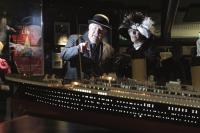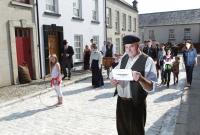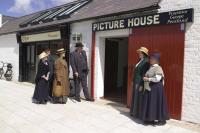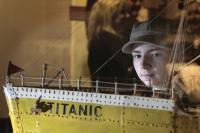TITANICa Ulster Folk and Transport Museum, Cultra, Co. Down
Published in 20th-century / Contemporary History, Issue 2(March/April 2012), Reviews, Volume 20
At the very centre of ‘TITANICa: the Exhibition’ is a scale model of the sinking ship. You can hear crackly interviews with several original crew members and survivors, and see tiny human models of everyone who lived—and died.
‘TITANICa: the Exhibition’ is located in the Transport Museum, and though there are artefacts recovered from the wreck, the focus is more on the small details, the personal objects and the human side of the people behind Titanic and her sister ships Olympic and Britannic, the Atlantic Class vessels that were all built in Belfast’s Harland & Wolff shipyard. As soon as you enter you’re transported into the world of the yard: sounds of crashing pipes, banging hammers and workmen shouting are heard. It’s a surprisingly effective and immersive feature. The exhibition itself is split into four circular segments, and though this design does mean that you easily lose the chronology it’s not a real inconvenience, though the very low light—necessary to protect some of the delicate material—often makes the other lighting bounce around off the display cases. The ‘Designing Titanic’ section begins with one of these personal elements: a ‘duncher’ or flat cap, a bowler hat and a top hat, all indicators of status in the shipyard (no prizes for guessing which was which). In the ‘Building Titanic’ section you’ll find the kids’ favourite: ‘A riveting challenge’ (a kind of ‘whack-a-mole’). I breezed through the ‘easy’ section, but ‘hard’—which reproduced what the best riveters working on the Titanic could do—seemed like disco lights.

‘TITANICa: the People’s Story’—across the road in the Folk Museum, home to the fictional village of Ballycultra.
Nearby, another personal display of ‘Tools of the trade’ showed the intimate connection that one of the shipwrights—who worked on the lifeboats—had with his work. The company didn’t supply tools, so the men would build up their own set until they retired; this collection still looked ready for use. Moving into the ‘Remembering Titanic’ section, there was a glass case of Titanic-themed ephemera, as well as posters, props, scripts and souvenirs from the various movies, including the inevitable Celine Dion CD. It was surprising how many of them featured the Titanic actually sinking, which showed how it has become such a part of popular culture and even phraseology (nearby was an elegant Atlantic Class wooden deckchair). Next was ‘Titanic stories’, and on its touch-screen you clicked an item (such as a foreman’s whistle, a drinks tray, a fancy lady’s hat, a hammer) and then saw and heard the descendants of people who worked on the Titanic relating their family story, or costumed actors recreating real-life accounts of life onboard. All the stories were engaging and interesting, and it was perhaps the best part of the exhibition. The other huge touch-screen in the ‘Designing Titanic’ section looked like a draughtsman’s table and allowed you to explore some of the Atlantic Class blueprints (deck plan, rigging, bulkheads, riveting and other areas). Sometimes it took a lot of heavy pokes, but archive photographs pop up everywhere and a nifty digital magnifying glass can enlarge anything you want.

The Picture House movie theatre, which originally operated in Gilford, Co. Down, from 1909 to 1931, has a flickering projector showing silent footage of the Titanic’s launch.
In the central ‘Sister ships’ section, there are the Olympic’s ornately decorated wooden fittings, furnishings, stairways and window frames, plus posters, postcards, pictures and tickets selling the Atlantic Class to the world. There’s also some recovered Titanic crockery, glassware, a hand mirror, perfume vials, labels and other artefacts, while at the very centre is a scale model of the sinking Titanic. You can hear crackly interviews with several original crew members and survivors, and see tiny human models of everyone who lived—and died. The proportion within the crew and third-class casualties is especially sobering.Going back outside, I drove a couple of minutes across the road to the Folk Museum, home to ‘TITANICa: the People’s Story’ at the fictional village of Ballycultra. I walked down the cobbled streets of Cluan Place—a row of working-class houses built in 1884 on the Albertbridge Road in east Belfast and moved here in the late 1980s—and stepped into the home of ‘Bob Carlisle’, one of the many riveters who worked on the Titanic. A coal fire burned brightly as he explained that, as a riveter, he earned more money than most of the workers at the yard. This meant that his house had bigger windows, a higher ceiling, gas lighting and even an outside flush toilet. He still worked hard, though; the hours were long, the foremen kept tabs on everyone, and the work was tough, loud and noisy. Like all his co-workers he was going deaf, and I asked why he didn’t protect his ears: ‘This is man’s work, at the shipyard. No one would dare do that.’Wandering further into the village I explored the tearoom, McCusker’s pub, the hardware shop, Sloane’s drapers, the dispensary and the old rectory, a seventeenth-century stone farmhouse from Lisnacloskey, Co. Antrim, with an open hearth and blackened chimney. All the buildings—and their inhabitants—have their own story and background. In the ‘rural’ section I found myself getting happily lost. Chickens were running free and there was the sound of running water, but then you came across the pound forge with its huge bellows, or the thatched Coshkib chicken farm, which was originally from the Glens of Antrim and had a wooden ‘slipe’ and its wicker creel (basket) in a stable outside.

A Meccano model of the Titanic.
(All images: National Museums Northern Ireland)
With time running out, I doubled back to the Diamond, which was dominated by the grander, steepled Anglican church and the smaller Presbyterian meeting-house nearby. The centre of town, it was also where you found Baird’s print shop, originally from Coleraine, and the Picture House movie theatre (operated in Gilford, Co. Down, from 1909 to 1931), which had a flickering projector showing silent footage of the Titanic’s launch. There was also the grand Northern Bank, the courthouse, the friendly post office (which looked like a modern ‘Irish’-themed pub) and the RIC barracks, with its extensive display on the history of policing in Ireland, a grim cell and chamber-pot, and a stand of rifles. It was nearly closing time, and I concluded that the TITANICa exhibitions were certainly worth a visit and that exploring Ballycultra would need more time than I had allocated. The Corner Shop was already closed, so no sweets for me, though I did get to wave at ‘Bob’ as he walked off down Tea Lane. HI
James Bartlett is a writer and journalist.
















